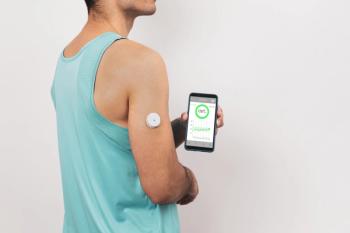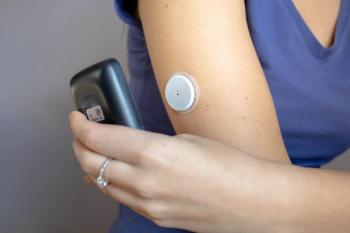
Assessing Impact of CGM on Progression of Coronary Atherosclerosis in Patients With T2D
The OPTIMAL trial assessed the effects of continuous glucose monitoring compared with HbA1c-guided glycemic control on the progression of coronary atherosclerosis in patients with type 2 diabetes mellitus.
Continuous glucose monitoring (CGM) may not slow coronary atherosclerosis in patients with type 2 diabetes mellitus (T2DM), according to study results published in the Journal of Diabetes and its Complications.1
For patients with T2DM, certain guidelines have recommended controlling glycated hemoglobin (HbA1c) levels to reduce the risk of macrovascular disease; however, because HbA1c reflects the average blood glucose levels over several months, it does not address fluctuations in glycemic control, which may affect cardiovascular outcomes in T2DM. Results from certain clinical trials suggest that the implementation of CGM may help to reduce such fluctuations in glycemic control, which may ultimately also delay the progression of coronary atherosclerosis in this patient population.
A team of investigators conducted the Observation of Coronary Atheroma Progression under Continuous Glucose Monitoring Guidance in Patients with Type 2 Diabetes Mellitus (OPTIMAL) study (Japan Registry of Clinical Trials: jRCT1052180152; University Hospital Medical Information Network Clinical Trial Registry: UMIN000036721) to assess the varying effects of CGM- and HbA1c-guided glucose control on the progression of coronary atherosclerosis in patients with T2DM with coronary artery disease (CAD) using serial intravascular ultrasound (IVUS) and near-infrared spectroscopy (NIRS) imaging.
The prospective, randomized, single-center trial randomly assigned patients with T2DM and CAD to either CGM- or HbA1c-guided glycemic control for 48 weeks. Patients were stratified by age, gender, high-intensity statin use, HbA1c values, and low-density lipoprotein cholesterol (LDL-C) values. The main study outcome was the nominal change in the total atheroma volume, which was measured via serial IVUS. The secondary study outcome measured the nominal change in maximum lipid-core burden index at 4-mm segment (maxLCBI4mm) via near-infrared spectroscopy imaging.
Eligible patients were those with T2DM between ages 18 and 85 years who had undergone a clinically indicated percutaneous coronary intervention (PCI) and had a nonculprit lesion with >20% diameter stenosis. Patients treated with antidiabetic agents who had a HbA1c value between 7% and 10% were eligible. Patients who had chronic kidney disease (estimated glomerular filtration rate at screening <40mL/min/1.73m2) or had already received, or planned to receive, a proprotein convertase subxilisin/kexin type 9 inhibitor were excluded from the study.
A total of 94 patients were randomly assigned to either the CGM-guided group (n=47) or the HbA1c-guided group (n=47). Of the cohort, 91 patients were assigned to glucose management (CGM-guided, n=46; HbA1c-guided, n=45). At both baseline and follow-up, 82 patients (CGM-guided, n=40; HbA1c-guided, n=40) had evaluable NIRS and IVUS imagining results. Additionally, no significant differences in baseline characteristics were noted for the 91 patients who underwent glucose management.
“At baseline, there were no significant differences between the two groups in the use of any anti-diabetic medication,” the investigators noted. More than half of the patient population received a dipeptidyl peptidase-4 inhibitor at baseline (P =.19). Compared with the HbA1c-guided group, there was a significant increase in the frequency of α-glucosidase use in the CGM-guided group throughout the study (P <.001 between baseline and 48 weeks). The CGM-guided group also had a significant decrease in the use of sulfonylureas compared with the HbA1c-guided group (P =.04 between baseline and 48 weeks).
In contrast, there was a significant increase in the use of glucagon-like peptide 1 agonists throughout the study among participants in the HbA1c-guided group (P =.04 between baseline and 48 weeks).At 48 weeks, all patients received a statin treatment; however, 70% of patients in both groups were treated with a high-intensity statin.
Compared with HbA1c-guided group, the CGM-guided group had a greater reduction in percent coefficient of variation (P =.01), as well as a greater increase in the duration with glucose between 70 and 180 mg/dL (P =.02).
The authors noted that “the primary efficacy measure, [total atheroma volume], increased by 0.11±1.9 mm3 in the HbA1c-guided group (P =.98 compared with baseline) and decreased by −3.29±2.00 mm3 in the CGM-guided group (P =.11 compared with baseline)” with a between-group difference of -3.4 mm3 (P =.22). The secondary efficacy measure was percent atheroma volume, which decreased by -0.19±0.27% in the HbA1c-guided group (P =.41 compared with baseline) and by 0.39±0.28% in the CGM-guided group (P =.20 compared with baseline). The between-group difference was -0.1% (P =.61).
Among patients in the HbA1c-guided group, the maxLCBI4mm increased by 90.1±25.6 (P <.001 compared with baseline) and by 50.6±25.6 in the CGM-guided group (P =.08 compared with baseline;). The between-group difference was -45.6 (P =.21). Results from a post-hoc exploratory analysis of NIRS/IVUS measures yielded a greater regression in the maxLCBI4mm among patients in the CGM-guided group (P =.03).
The authors noted that several recent studies have “demonstrated the predictive ability of maxLCBI4mm for future occurrence of coronary events” and while the current analysis was exploratory, the CGM-guided 48-week glycemic control “may modify plaque quality rather than its quantity, which ultimately results in the prevention of future coronary events.”
“Due to smaller study population and shorter follow-up period, the statistical power to detect the efficacy of CGM-guided glycemic control on coronary atherosclerosis is limited,” the investigators noted. “Future randomized controlled trial with adequate sample size and longer follow-up period is required to elucidate the effect of this treatment approach on plaque stabilization.”
Reference
1. Kataoka Y, Kitahara S, Funabashi S, et al. The effect of continuous glucose monitoring-guided glycemic control on progression of coronary atherosclerosis in type 2 diabetic patients with coronary artery disease: the OPTIMAL randomized clinical trial. J Diabetes Complications. Published online August 23, 2023. doi:10.1016/j.jdiacomp.2023.108592
Newsletter
Pharmacy practice is always changing. Stay ahead of the curve with the Drug Topics newsletter and get the latest drug information, industry trends, and patient care tips.















































































































